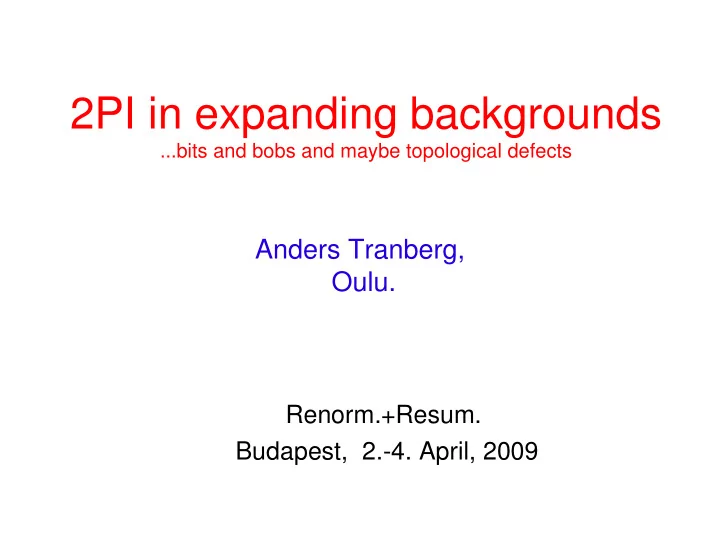

2PI in expanding backgrounds ...bits and bobs and maybe topological defects Anders Tranberg, Oulu. Renorm.+Resum. Budapest, 2.-4. April, 2009
An expanding Universe First principles lattice field theory simulations? Inflation. Unlikely. • End of inflation (warm inflation?) Sort of. • Non-perturbative preheating. Maybe. • Perturbative reheating. Probably. • Out-of-equilibrium phase transitions. Definitely. • Less out-of-equilibrium phase transitions. Yep. • Baryogenesis. In principle, yes. In practice... • Out-of-equilibrium decay. Yep. •
Tool box Quantum equilibrium: Dimensional reduction, MC. • Classical dynamics: Hamiltonian equations of motion, MC. • 2PI dynamics: Quantum corrections, correct thermalization. • Lattice discretization. • Issues to be resolved: How does the scale factor enter in the evolution equations? What kind of observables are of interest? Range of applicability: Finite box! Keep gravity classical: Semi-classical Friedmann equation, How to renormalize the energy density?
Omkring den varme gröd... • Warm inflation postulates particle creation during inflation, large enough to a) sustain a net radiation energy density which b) induces over-damped motion of the inflaton through back- reaction. Topological defects are created in symmetry breaking phase • transitions, if the symmetry group is “smaller” than the space time. Z(2) in 1D (kinks), O(2) in 1D (textures), O(2) in 2D (vortices), O(2) in 3D (strings). Need cooling to see them over thermal noise. • Equilibration in an expanding box, thermalization, mean field dynamics, preheating. Requires renormalization of the Friedmann equation.
Solution 1: Neglect expansion I n “warm inflation”, particles are created as the inflaton rolls. Fast enough to compensate for cosmological dilution. Inflaton rolls slowly (overdamped) Massive χ has time-dependent mass χ -particles decay to massless σ -particles, which thermalize. Does it work if we ignore dilution?(!)
Particle creation and warm inflation (Aarts, AT: 2007) Three effects determine evolution of χ- correlator 1) Adiabatic change due to the change of mass 2) Non-adiabatic particle creation, suppressed by velocity of ϕ 3) Decay of these particles via the σ -channel
Particle numbers and decay Particle creation at the end of inflation, as non- adiabaticity kicks in. With expansion? Particles have no time to decay. Time scales don't work out. Question of parameters?
Solution 2: Keep the most important expansion effect Back-reaction on the inflaton leads to (over-)damped evolution Ignore σ -sector (doesn't matter...). Ignore expansion for χ -sector (does matter...). Keep expansion for ϕ -field to have slow-roll. Damping from expansion (H) and back-reaction ( ϒ ). Changing mass from back-reaction (M). Who wins?
Thermal effects on slow-roll dynamics (Aarts, AT: 2007) •
Solution 3: “Transverse expansion” Postulate anisotropic metric in 2+1D. Postulate that the field is independent of y. Hubble dilution without redshift(!) Damped oscillations. 1/N expansion with N=1,2 and 4?! N>1 quantitatively ok. N=1? (Aarts, Berges: 2001, Aarts, Laurie, AT: 2008)
Signature of defects in the propagator? Z(2): Kinks in 1D. “gas” of kinks with density n and thickness d. O(2): Textures in 1D: “freeze-out scale” ξ O(4): Nothing. Asymptotically G=0. (Rajantie, Tranberg: 2006) • Classical MC simulations: Individual configurations have defects. Calculate the propagator. • 2PI classical simulations: No configurations, ensemble is homogeneous. Calculate the propagator.
Early times
Late times
Sticking my neck out, by saying... ...that 2PI cannot see defects, because in a diagrammatic implementation, it is “perturbative (1)”, even though it is maybe not “perturbative (2)”, because of resummations. Perturbative (1): Is a power expansion in some parameter. Perturbative (2): Assumes small field perturbations. The equality sign only holds up to non-analytic corrections(?) I have no clue how to show either way...
Solution 4: Expanding box Co-moving lattice means physical cut-off decreases. Get worried about lattice artefacts when spacing becomes too big. Inflation is not on! Post-inflationary dynamics . Large range of temperatures! Phase transitions. Can’t solve the problem, but apply the approach where it works! AT: JHEP 0811:037, 2008 (arXiv:0806.3158).
Evolution equations in FRW background Go to conformal time, rescale the field: • Classical equation of motion: • 2PI equations of motion: • Self-energies independent of scale factor. NLO in coupling • expansion, Figure-8, Pippi, Basketball. (Berges and Cox, 2001, Arrizabalaga, Smit, AT, 2005)
Renormalization of the energy density • Renormalize at 2PI-LO (Hartree). Use mass and energy counterterms only. (In the spirit of Arrizabalaga, Smit, AT, 2005) • Must choose a vacuum! Changes because “external field” is changing. • Solve WKB equation to order . Use solution to define the vacuum. Renormalize and define particle numbers relative to this vacuum. (Adiabatic regularization, Anderson, Molina-Paris, Mottola, 2005) • Cancels all quartic and quadratic divergences. Leaves log- divergences, • NLO contribution has all order divergences, but suppressed by the coupling. In practice it is small, but obvious scope for improvement.
Free “thermal” field
Oscillating free field is matter?
Kinetic equilibration
Chemical equilibration
Staying in kinetic equilibrium?
Staying in chemical equilibrium?
Conclusions In practice(!), real-time quantum field dynamics in expanding • backgrounds is possible. Choose phenomenon of interest. Estimate -range. See if it fits • into your lattice. Choose 2PI expansion and truncation. Modify 2PI equations as • for classical equations of motion. Renormalize energy density relative to “adiabatic” vacuum. • But! A posteriori check that UV was indeed under control. • Check that level of renormalization is adequate. It can be • systematically improved. Checks of other methods: Equilibrium assumptions, Boltzmann • equations etc. Expansion history of the Universe: Connect known equilibrium • eras:
Recommend
More recommend